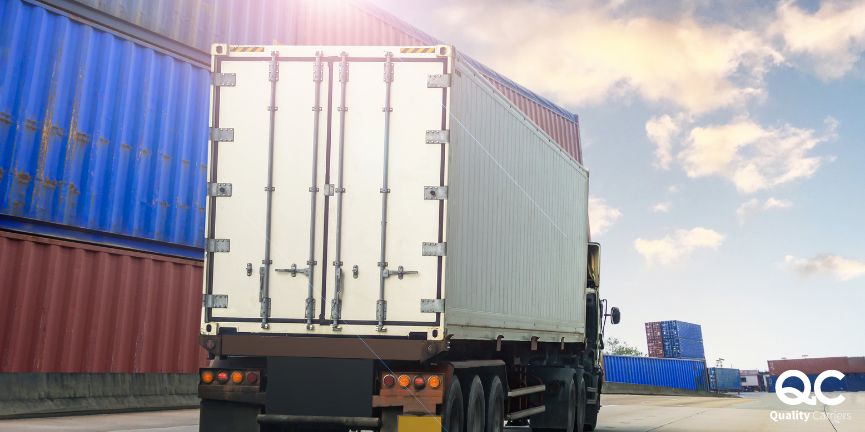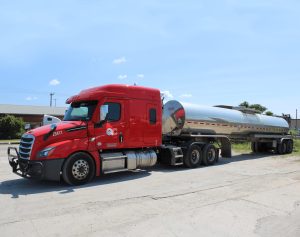Becoming an owner-operator in the trucking industry is an enticing path for many drivers seeking autonomy and the potential for increased earnings. This role involves operating your own business, making critical decisions, and managing the daily operations of a trucking venture.
This blog will explore what it means to be an owner operator and what the role entails. We will also provide a step-by-step guide on transitioning into this position.
What Is an Owner Operator?
An owner operator is a self-employed commercial truck driver or a small business owner who owns and operates a trucking business. They own their vehicles and haul freight independently or under lease agreements with larger truck companies. Owner operators can choose their routes and loads, but with this freedom comes the responsibility of managing their business operations.

What Do I Need to Be an Owner Operator?
To become an owner-operator, you need practical driving experience, business acumen, and financial resources to start and sustain your operations. Essential elements include:
- A Commercial Driver’s License (CDL).
- A well-maintained truck.
- Insurance.
- The ability to comply with all regulatory requirements.
Owner Operator Responsibilities
Owner-operators are not just truck drivers; they are business owners. Their responsibilities extend beyond driving to include:
- Managing business finances, including billing, invoicing, and paying expenses.
- Maintaining their vehicle(s) to ensure they are safe and operational.
- Complying with all transportation laws and regulations.
- Marketing their services to find and retain clients and negotiate contracts.
Owner Operator Requirements
To legally operate as an owner-operator, you must:
- Obtain a CDL with the appropriate endorsements for the loads you plan to carry.
- Secure insurance coverage that meets industry standards and protects against liability and cargo-related risks.
- Register for a USDOT number and a Motor Carrier (MC) number if operating under your authority.
- Meet all state and federal regulations, including periodic inspections and environmental compliance.
Steps To Become an Owner Operator
Step 1: Determine If Being an Owner Operator is Fit for You
Before becoming an owner-operator, you must assess if this career aligns with your professional goals. Consider the responsibilities of managing your business, from financial obligations to the daily tasks of logistics and maintenance. Reflect on your ability to handle irregular hours, extended periods away from home, and the discipline required to manage driving and business operations.
Step 2: Research the Industry. Talk with Other Owner Operators
Gain insights into the industry by networking with experienced owner operators. Attend trucking forums, join relevant online communities, or attend local trucking association meetings. Engage with peers to learn about the challenges and rewards of being an owner-operator. Inquire about market conditions, best practices for maintenance and operations, insurance tips, and strategies for securing profitable freight contracts.
Step 3: Get Your Commercial Driver’s License (CDL)

Obtaining a CDL is a fundamental requirement to operate heavy commercial vehicles legally. Enroll in a reputable CDL training program that prepares you to pass the driving test and educates you on commercial trucking regulations and safety procedures. Pick a training program that fits your schedule and budget, and be prepared to complete written and practical examinations.
Step 4: Decide If You’re Going to Operate Under Your Authority or Lease a Truck
This decision is crucial as it impacts your level of control, startup costs, and potential earnings. Operating under your authority means obtaining a Motor Carrier (MC) number and a USDOT number, which allows you to haul freight independently. This option typically requires more upfront investment but offers higher potential returns and greater autonomy. Alternatively, leasing a truck from an established company can lower initial costs and provide more immediate work. However, it may come with higher ongoing expenses and less control over which loads you take.
Step 5: Create a Business Plan
A comprehensive business plan is essential for the success of any venture, including a trucking business. Your plan should detail your business model, market analysis, operations strategy, and growth goals. It should also include sections on how you’ll secure loads, manage operations, handle maintenance, and comply with regulations. Financial projections, such as startup costs, ongoing expenses, and revenue forecasts, should be thoroughly outlined to ensure viability and assist in securing any necessary financing.
Step 6: Assess Your Finances
Before starting the owner operator role, thoroughly evaluate your financial situation. Determine the amount of capital required to start your trucking business, considering expenses such as the purchase or lease of a truck, insurance, licensing, and initial operating capital. Review your savings, explore financing options like loans or leasing programs, and consider potential income to ensure that you can sustainably manage cash flow. It’s also wise to establish a buffer for unexpected costs and slow periods in the business.
Step 7: Have an Organized Accounting System
Financial management is crucial for the success of any business, especially for owner-operators in the trucking industry. Implementing a robust accounting system helps track expenses, manage invoices, and prepare for tax obligations. Consider using accounting software tailored for small businesses or specifically designed for the trucking industry. This software can help monitor your cash flow, fuel costs, maintenance expenses, and client payments. You can work with a professional accountant or financial advisor familiar with the trucking industry, which is also beneficial to ensure compliance with tax laws and optimize financial operations.
Step 8: Get Insurance Coverage
Insurance is critical to the trucking business, protecting you against liabilities and unexpected costs arising from accidents, damages, or theft. Essential types of insurance for owner operators include:
- Liability Insurance: This covers damages or injuries to others in case of accidents.
- Cargo Insurance: Protects the freight you’re hauling.
- Physical Damage Insurance: This covers repairing or replacing your truck and trailer in case of an accident or other damage.
- Non-Trucking Liability (Bobtail Insurance): Provides coverage when driving the truck without hauling cargo.
Shop around and consult with insurance agents specializing in trucking to find the best coverage options that meet legal requirements and offer adequate protection.
Step 9: Start Finding Your Truck Loads
Once your truck and insurance are in place and your business is ready to operate, the next step is to find loads to haul. You can start by registering with load boards and online marketplaces that connect freight brokers and shippers with trucking services. Building relationships with freight brokers can also help secure consistent work. Networking in the industry, attending truck shows, and joining trucking associations can provide valuable connections and lead to direct contracts with shippers. Effective marketing and establishing a good reputation for reliability and timely delivery will help grow your business.
Conclusion
Becoming an owner operator is a significant step that requires careful planning and dedication. You can build a successful and sustainable trucking business by understanding the industry, creating a solid business plan, and maintaining your equipment. Remember, becoming an owner-operator is a journey of continuous learning and adaptation.
Owner Operator FAQs
Startup costs vary significantly but typically include the truck’s price, insurance, licensing, and initial business setup fees.
Success can vary widely, but owner-operators often have the potential to earn more if they manage their business wisely and control their expenses effectively.
The timeline can vary based on your experience level, financing arrangements, and how quickly you can acquire the necessary licenses and equipment. Generally, it could take a few months to over a year.
No money? Read this blog for more details – How do I become an owner-operator with no money?




